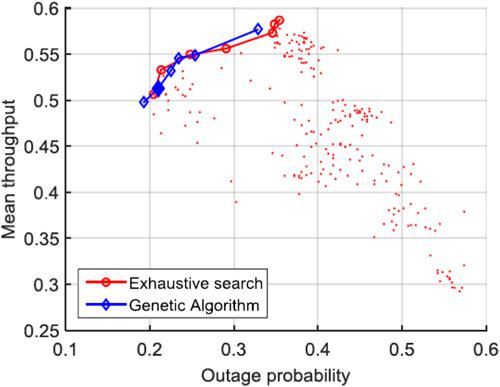当前位置:
X-MOL 学术
›
Int. J. Commun. Syst.
›
论文详情
Our official English website, www.x-mol.net, welcomes your
feedback! (Note: you will need to create a separate account there.)
Genetic algorithm for biobjective optimization of indoor LTE femtocell deployment
International Journal of Communication Systems ( IF 1.7 ) Pub Date : 2020-08-02 , DOI: 10.1002/dac.4564 George E. Figueras-Benítez 1, 2 , Renny E. Badra 1
International Journal of Communication Systems ( IF 1.7 ) Pub Date : 2020-08-02 , DOI: 10.1002/dac.4564 George E. Figueras-Benítez 1, 2 , Renny E. Badra 1
Affiliation

|
The optimization of indoor femtocell base stations (FBS) placement is a highly complex problem in which multiple performance figures can be considered. In this paper, we propose a biobjective optimization approach based on non‐dominated sorting genetic algorithm II (NSGA‐II) to solve the indoor FBS deployment problem in residential scenarios where a single cell is deployed within the coverage of a single dominant interfering external macro base station (MBS). The optimization problem is formulated with the objective of jointly minimizing outage probability and maximizing normalized downlink average throughput. Several conditions are simultaneously considered under the framework of Monte Carlo simulations, such as the effect of co‐channel interference in uplink and downlink, buildings with arbitrary layouts, realistic transmission schemes and antenna radiation patterns, random user distributions, and a well‐established empirical path loss model. The proposed algorithm, which determines the location and orientation of the FBS's antenna that provides a suitable compromise between the two objective functions, is evaluated in this paper. First, two different experiments are proposed to investigate the algorithm convergence; then, statistical analyses are formulated to characterize the relation between the values achieved for both objective functions; finally, the computational load is evaluated. Results indicate the convergence of the proposed method towards the real Pareto front and a significant reduction of the computational time with respect to a reference method based on exhaustive search, while pointing at new criteria for the selection of the objective functions.
中文翻译:

室内LTE毫微微小区部署的双目标优化遗传算法
室内毫微微小区基站(FBS)位置的优化是一个高度复杂的问题,其中可以考虑多个性能指标。在本文中,我们提出了一种基于非支配排序遗传算法II(NSGA-II)的双目标优化方法,以解决在单个显着干扰外部宏覆盖范围内部署单个小区的住宅场景中的室内FBS部署问题。基站(MBS)。提出优化问题的目的在于共同最小化中断概率并最大化归一化的下行链路平均吞吐量。在蒙特卡洛模拟的框架下,同时考虑了一些条件,例如,上行和下行中的同信道干扰的影响,具有任意布局的建筑物,现实的传输方案和天线辐射方向图,随机的用户分布以及完善的经验路径损耗模型。本文评估了所提出的算法,该算法确定FBS天线的位置和方向,从而在两个目标函数之间提供适当的折衷。首先,提出了两个不同的实验来研究算法的收敛性;然后,进行统计分析以表征两个目标函数所达到的值之间的关系;最后,评估计算负荷。结果表明,相对于基于穷举搜索的参考方法,所提出的方法朝着真实的帕累托前沿收敛,并且显着减少了计算时间,
更新日期:2020-10-05
中文翻译:

室内LTE毫微微小区部署的双目标优化遗传算法
室内毫微微小区基站(FBS)位置的优化是一个高度复杂的问题,其中可以考虑多个性能指标。在本文中,我们提出了一种基于非支配排序遗传算法II(NSGA-II)的双目标优化方法,以解决在单个显着干扰外部宏覆盖范围内部署单个小区的住宅场景中的室内FBS部署问题。基站(MBS)。提出优化问题的目的在于共同最小化中断概率并最大化归一化的下行链路平均吞吐量。在蒙特卡洛模拟的框架下,同时考虑了一些条件,例如,上行和下行中的同信道干扰的影响,具有任意布局的建筑物,现实的传输方案和天线辐射方向图,随机的用户分布以及完善的经验路径损耗模型。本文评估了所提出的算法,该算法确定FBS天线的位置和方向,从而在两个目标函数之间提供适当的折衷。首先,提出了两个不同的实验来研究算法的收敛性;然后,进行统计分析以表征两个目标函数所达到的值之间的关系;最后,评估计算负荷。结果表明,相对于基于穷举搜索的参考方法,所提出的方法朝着真实的帕累托前沿收敛,并且显着减少了计算时间,











































 京公网安备 11010802027423号
京公网安备 11010802027423号